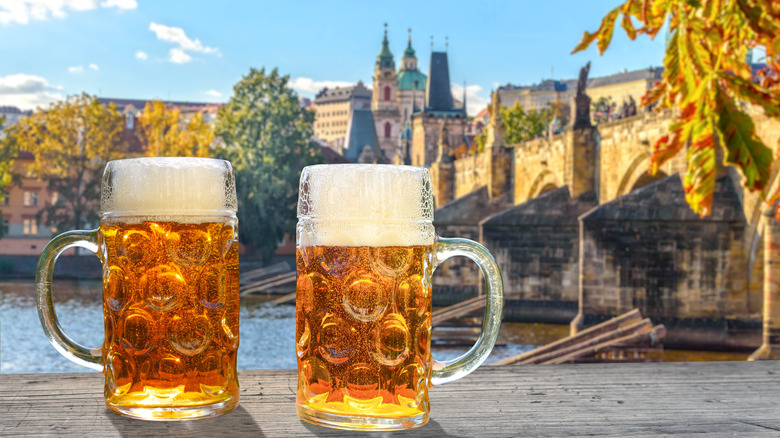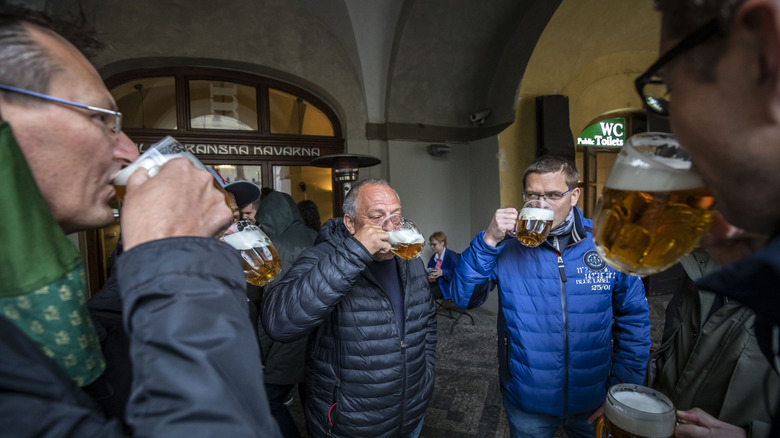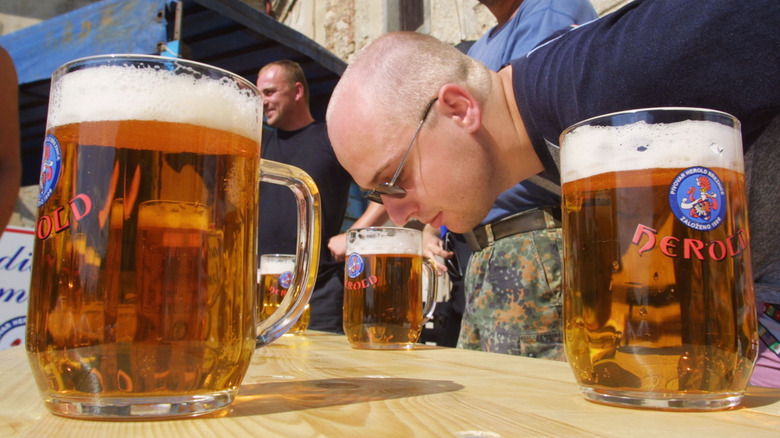Rick Steves' Big Warning About 'Czech Knees' While Visiting Czechia
Prague is a hugely popular tourist destination and Czech brews are a major part of the appeal for beer lovers. Not only is a quality pint very cheap compared to many other European countries, it is also regarded as some of the best in the world. Furthermore, while the magnificent sights of Charles Bridge and Old Town Square are great for a few snaps, it is Czechia's pubs and beer halls where you will get a true insight into how the people tick. But sip with caution — if you are not used to Czech beer, you might end up with what travel expert Rick Steves refers to as "Czech knees" (per his website).
Czechs are typically a modest people but one subject that will get them waxing lyrical is their cherished beer. Hops have been brewed in this part of the world for over 1,000 years and the nation's favorite beverage is an integral part of day-to-day life. You can even bathe in beer at certain locations in the country. Although consumption is trending downward, Czechs still drink more beer per head than any other nation.
Slow and steady wins the race, and Czech beer stats are maintained by consistent consumption day after day, week after week. In short, Czechs know how to handle their beer and it is probably not a good idea to try matching their pace if you are unfamiliar with it. While Czech beer isn't necessarily stronger than suds you might normally drink back home, it can hit differently.
Why Czech beer feels stronger
Rick Steves admits that it took him a few trips to Czechia before he realized that "Czech beer is more powerful than other beers." To understand why, we need to take a look at how Czech beer is measured compared to other countries like the United States. There, the standard indicator of an alcoholic beverage's potency is ABV (alcohol by volume), with a popular lager like Budweiser clocking in at 5%.
This percentage is purely a measurement of alcohol content. By contrast, Czech beer is measured by degrees on the Plato Scale. This indicates the sucrose content (produced by the wort during fermentation) by weight. The dedication to high-quality natural ingredients is what gives Czech brews their rich, crisp, and full-bodied flavor. While some strong craft ales go up to 20 degrees, most of Czechia's iconic beers usually range from 10 to 12 degrees. These numbers roughly translate to around 4% ABV for a 10-degree beer and almost 5% for a 12-degree like Pilsner Urquell or Budvar.
This more robust flavor is why Czech beers are often regarded as superior, but that density also contributes to the "Czech knees" that Rick Steves has experienced in the past. While it might not be stronger alcohol-wise, it can certainly feel more heavy and powerful if you aren't familiar. On the flip side, if you are used to Czech beer and drink fizzier lager like American Budweiser instead, it can make you feel rather tipsy!
Skip beer at lunch if you want to get anything done
Rick Steves observed that Czechs will often enjoy a beer with their lunch and advised against following suit if you plan to get any sightseeing done in the afternoon: "I used to have a big beer at lunch and spend the rest of the day wobbly ... sightseeing on what I called 'Czech knees.'" Many Czechs like to take their lunch break early with daily specials in restaurants usually starting at around 11 a.m. to cater for this trend. However, it might be worth abstaining until later in the day if you want to stay active in the afternoon.
Early evening is when you will see the country's beer culture fully flourish. Going to the pub with friends after work is an immensely popular pastime for many Czechs. The scene is far more easy-going than in some other western countries and enjoying a few beers over lively conversation is revered for its social aspect. Table service is the norm so you won't have to fight your way to the bar to get each round, and the pace is steady rather than throwing back drinks just to get drunk. Of course, there are places where people do this, but the Czech pub environment is generally relaxed and convivial. Just beware if any of your new drinking buddies suggests a round of shots to go with the "pivo" – that will almost certainly rule out sightseeing the next day for unwary visitors!


